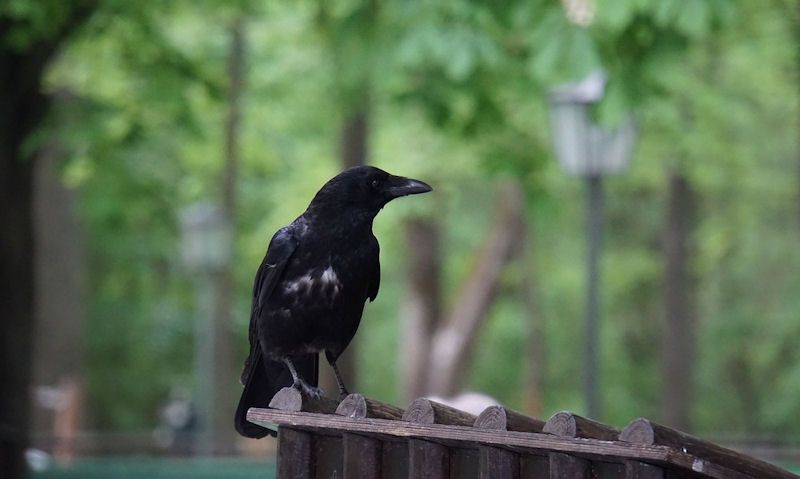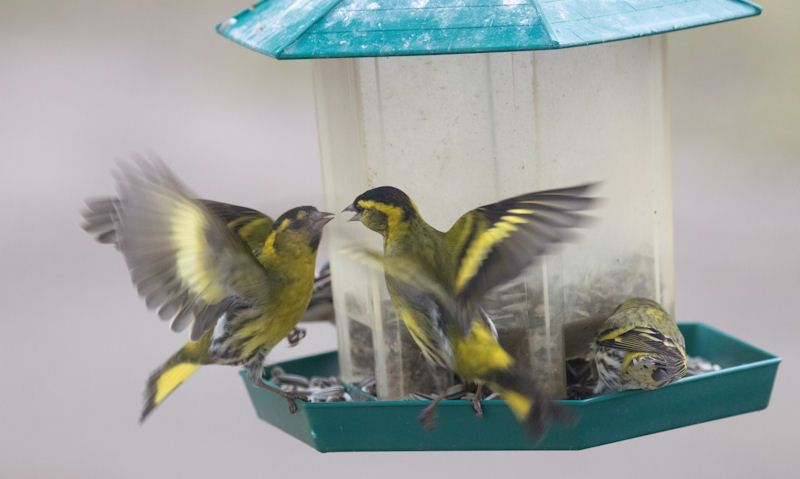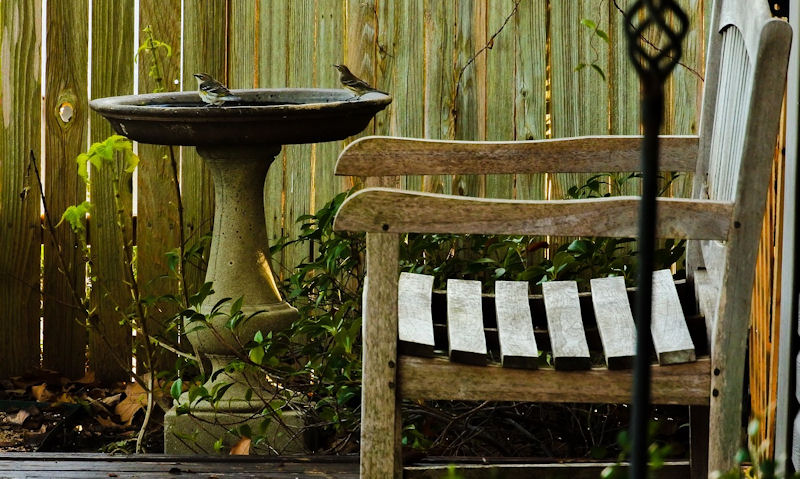How to keep Crows out of garden
Its not easy keeping wildlife away from your garden, but it could be possible if you're willing to put in the time and effort.
To keep crows out of the garden you need to first remove all food sources. That includes bird feeders, a bird table and even a bird bath. Remove the stand or brackets to clear all signs of feeders being present. Its then over to you to cover up natural plants, trees - including the lawn - with netting to stop crows feeding.
Remember crows are incredibly clever and very cunning, so while I outline how to keep crows of the garden can work, its not a guarantee.
In doing so though you will be deterring the pleasant small garden birds away in the meantime, but remember its for there own wellbeing.
Crows can be a menace to small birds and there chicks, so in time it will benefit them.
But to keep crows out of the garden you do need to prevent all birds visiting; so remove all signs of bird food, including a water source if you have one.
Bird feeders will need to be removed and so will there corresponding equipment used to either hang them up, or the stands used to impale into the lawn.
No food can be present including that grown in the wild, so while you can't and should never remove berry bushes for example, you can cover them up.
Fruit bushes need to continue to thrive in the sunshine with rain to flourish, so you can use a netting that would otherwise be used to stop birds nesting in trees.
More difficult is covering up your lawn - only if its a small area mind you - with netting spread across the grass a foot or so above the ground.
Crows are ground feeding birds so your lawn or an area with soil will need to be covered up to stop the larger, nuisance birds freely feeding on bugs.
While crows do eat meat, they can but are less likely to target small garden birds.
Having taking all that onboard, you can now think about feeding crows far away from your property as to give them no reason to venture any further.
This is all a long process so while the crows - including the small garden birds - are gone, its not to say they will return as soon as the food source is back.
Temporarily stop feeding birds
Continuing to feed the more friendly, pleasant small garden birds that visit you garden will now have to be put on hold.
In order to keep crows out of the garden you need to remove all bird food sources.
That includes all hanging bird feeders, a bird table and even the bird bath, for now. More importantly, clean up any food you have thrown over the lawn for ground feeding birds.
While the right-on-cue visit from the Robins, Tits and Sparrows into the garden will be missed, it can be reversed - but only once you've got rid of the crows.
To deter crows the absence of food will give them time to move on, and hopefully a long way away from your garden.
Now after several days to weeks with no crow in sight for ages; why not hang the bird feeder back up with only a small amount of fat balls, peanuts or seeds.
If the crows are back in a heartbeat its time to remove them once again, leaving a longing gap this time until they disappear indefinitely.
Remove all signs of bird feeders
Birds who visit your garden will do so for two reasons; first, its mostly to do with food sources that are commonly found in gardens, and two, its a water source.
Less so with a water source if you use a bird bath or have a pond, but more to do with bird feed often left out in purpose built feeders.
It could be, but less so the presence of small vulnerable birds with there chicks that could be a target for larger, predatory birds such as crows.
Its now time to remove all signs of bird feeders which could be the popular hanging fat balls or seed feeders, but it must all go.
If you have a bird table - an open or covered design table - it must also be cleared up of all food.
Ideally putting the wooden bird table away in the shed for now will be more effective. That is also true if you're using a bird feeding station on a poling system.
Remove all signs of objects crows usually associate with food, including manmade items that are made to store different kinds of bird feed.
Netting to cover fruit bushes
It gets a little more difficult if you're not feeding birds using feeders or a bird table for example, when it fact the natural surroundings in your garden is tempting crows to land.
What I mean by that is you could have a fruit growing plant or bush in your garden that can be purged by crows.
Now you absolutely cannot uproot this nutrient plant as its vital for small garden birds to feed on, so it stays put.
However, the solution might be a little more simple than you would think, namely netting.
This netting is often used to cover tree's by property builders or homeowners who wish to prevent birds nesting in there garden tree.
So what they will do is cover the entire tree with this netting to prevent birds finding a way to nest - which people cannot remove if they do nest - or to feed off a smaller berry plant.
This is where covering your fruit bush with netting will help prevent crows from feeding off the bush, thus giving the crows no reason to visit your garden.
Its not a straight forward project mind you as berries and other fruits can still be reached as crows are cunning as the are clever.
In that respect you will want to create space between the netting and bush of up to a foot by using a makeshift, DIY fencing or post.
Clean or cover up lawn or ground
Crows are well known ground feeding birds so as long has you have a lawn or an area of soil where insects or bugs are present, crows will come calling.
Once again its up to you to stop the birds feeding in your garden in an effort to keep them away indefinitely, and covering up the whole garden is not an easy one.
So only take in this advice if you only have a very small patch of lawn or soil where you perhaps grow plants or flowers.
Remove all items off the lawn while hammering in several stakes a foot or so off the ground, as to create space between the lawn and the space open above it.
Then cover the area with a large piece of netting which I have previously mentioned before, that would otherwise be used to prevent birds from nesting in trees.
The idea of this is to prevent crows from eating worms or other bugs off the lawn, especially in the wet weather.
Repeat this process for all other areas that are connected to the earth in your garden, such as flower beds or around the garden fence boundary.
This is only a temporary fix of deterring crows, so in time with no signs of crows around, you can remove the netting again.
Divert attention outside garden boundary
Only once you've removed all signs of food, drink and bathing sources out of your own garden, can you then move outside your garden boundary.
What I mean is removing food sources may not be enough alone, so you need to offer food sources away from your garden.
In doing so you will not be feeding crows in a neighbours garden, nor will you be throwing bird feed over any private property.
What is needed on your behalf is understanding where the crows might be coming from; it could the direction they visit your garden from, or perhaps a tree line or area you think they might be nesting.
In the route they take to reach you garden - which is probably a straight line - you will need to find a piece of open land - a green area if you like to throw bird feed over.
It must be available for you to do so, so ideally council owned.
On top of that make sure its still far enough from your home as keeping crows nearby won't be effective if you plan to get rid of them forever.
Simply throw over household scraps or the quality bird feed if you can spare it, but don't be too generous as to create a mess.
In this time you will want to divert the crows attention to this open area to feed to keep them away from your own garden.
Obviously, activity in a neighbours garden cannot be ignored, to which you will have to work with your neighbour as a team - making sure you're in sync to deter crows.
Conclusion
Its simple, to keep crows out of your garden you must remove food sources that are otherwise available to the smaller birds you wish to attract.
That means those smaller wild birds will have to go without for the time being.
In this time you will not only remove the bird feeders filled up with seeds, peanuts or the more popular fat balls, but the adjoining stands, brackets and hoops used to hang them up.
Best thing you can do here is move all bird feeding equipment to an outdoor metre shed or a wooden garden shed, but ideally keeping them out of the house for hygiene reasons.
Presence of bird feeding equipment could keep the crows coming back, so you do need to remove all signs of them.
And if you have a bird bath that needs to be emptied and put away too, along with a pond you can cover with netting.
If crows are attracted to your plants or trees where fruits are grown, then this all needs to be covered up with netting - which is otherwise used to prevent birds from nesting.
This major clean up also applies to the lawn or patio that is connected to the earth; if so then its likely to house bugs and insects that crows are attracted too.
Crows are ground feeding birds so will be happy to feed off the lawn if there's no other easy to reach food sources.
Its not easy but with a little imagination the lawn or patio can be covered with netting.
Finally, you can go one better - but still taking onboard all advice outlined above - by diverting the attention of the crows to new feeding grounds.
Simply throw over scraps or bird feed on an area far away from your garden you know they will pass or occupy.
In time crows could get used to that while the smaller birds can return to your garden.


